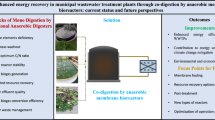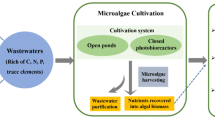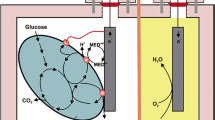Abstract
Due to the presence of various types of hydrogen-producing bacteria and numerous organics such as protein and carbohydrate, sewage sludge is a potential material for biological hydrogen production. In this study, two batch tests were carried out to investigate the impact of alkali and heat pretreatment on the pathway of hydrogen production from sewage sludge. The results showed that the heat treatment had a stronger lethal effect on bacteria than the alkali treatment, and could effectively kill hydrogen-consuming bacteria. The heat treatment was more suitable for enriching acidophilic hydrogen-producing bacteria, while the alkali treatment was more suitable for enriching basophilic hydrogen-producing bacteria. A maximum hydrogen production of 10.32 mL/g-COD from alkali pretreated sludge was obtained at an initial pH of 11; while a maximum hydrogen production of 8.94 mL/g-COD from heat pretreated sludge was obtained at an initial pH of 5. Hydrogen production in alkali conditions (pH>9) from alkali pretreated sludge mainly depended on the fermentation of protein by protein-utilizing bacteria; whereas hydrogen production in acidic conditions (pH<6) from heat pretreated sludge mainly depended on the fermentation of carbohydrate by glucose-utilizing bacteria.
Similar content being viewed by others
References
Appels L, Baeyens J, Degreve J, et al. Principles and potential of the anaerobic digestion of waste-activated sludge. Prog Energy Combust Sci, 2008, 34: 755–781
Gujer W, Zehnder A J B. Conversion processes in anaerobic-digestion. Water Sci Technol, 1983, 15: 127–167
Spyros G. Pavlostathis J M G. A kinetic model for anaerobic digestion of biological sludge. Biotechnol Bioeng, 1986, 28: 1519–1530
Nah I W, Kang Y W, Hwang K Y, et al. Mechanical pretreatment of waste activated sludge for anaerobic digestion process. Water Res, 2000, 34: 2362–2368
Tiehm A, Nickel K, Zellhorn M, et al. Ultrasonic waste activated sludge disintegration for improving anaerobic stabilization. Water Res, 2001, 35: 2003–2009
Lin J G, Chang C N, Chang S C. Enhancement of anaerobic digestion of waste activated sludge by alkaline solubilization. Bioresour Technol, 1997, 62: 85–90
Bougrier C, Delgenes J P, Carrere H. Effects of thermal treatments on five different waste activated sludge samples solubilisation, physical properties and anaerobic digestion. Chem Eng J, 2008, 139: 236–244
Tanaka S, Kobayashi T, Kamiyama K I, et al. Effects of thermochemical pretreatment on the anaerobic digestion of waste activated sludge. Water Sci Technol, 1997, 35: 209–215
Kim J, Park C, Kim T H, et al. Effects of various pretreatments for enhanced anaerobic digestion with waste activated sludge. J Biosci Bioeng, 2003, 95: 271–275
Wang C C, Chang C W, Chu C P, et al. Producing hydrogen from wastewater sludge by Clostridium bifermentans. J Biotechnol, 2003, 102: 83–92
Guo L, Li X M, Bo X, et al. Impacts of sterilization, microwave and ultrasonication pretreatment on hydrogen producing using waste sludge. Bioresour Technol, 2008, 99: 3651–3658
Chen C C, Lin C Y, Lin M C. Acid-base enrichment enhances anaerobic hydrogen production process. Appl Microbiol Biotechnol, 2002, 58: 224–228
Zhu H G, Beland M. Evaluation of alternative methods of preparing hydrogen producing seeds from digested wastewater sludge. Int J Hydrogen Energy, 2006, 31: 1980–1988
Lee M J, Song J H, Hwang S J. Effects of acid pre-treatment on bio-hydrogen production and microbial communities during dark fermentation. Bioresour Technol, 2009, 100: 1491–1493
Cheong D Y, Hansen C L. Feasibility of hydrogen production in thermophilic mixed fermentation by natural anaerobes. Bioresour Technol, 2007, 98: 2229–2239
Datar R, Huang J, Maness P C, et al. Hydrogen production from the fermentation of corn stover biomass pretreated with a steam-explosion process. Int J Hydrogen Energy, 2007, 32: 932–939
Lu Y, Lai Q, Zhang C, et al. Characteristics of hydrogen and methane production from cornstalks by an augmented two- or three-stage anaerobic fermentation process. Bioresour Technol, 2009, 100: 2889–2895
Ren N Q, Guo W Q, Wang X J, et al. Effects of different pretreatment methods on fermentation types and dominant bacteria for hydrogen production. Int J Hydrogen Energy, 2008, 33: 4318–4324
Mu Y, Yu H Q, Wang G. Evaluation of three methods for enriching H-2-producing cultures from anaerobic sludge. Enzyme Microb Technol, 2007, 40: 947–953
Mohan S V, Babu V L, Sarma P N. Effect of various pretreatment methods on anaerobic mixed microflora to enhance biohydrogen production utilizing dairy wastewater as substrate. Bioresour Technol, 2008, 99: 59–67
Cai M L, Liu J X, Wei Y S. Enhanced biohydrogen production from sewage sludge with alkaline pretreatment. Environ Sci Technol, 2004, 38: 3195–3202
Xiao B Y, Liu J X. Biological hydrogen production from sterilized sewage sludge by anaerobic self-fermentation. J Hazard Mater, In Press, Corrected Proof.
Xiao B Y, Liu J X. Effects of thermally pretreated temperature on bio-hydrogen production from sewage sludge. J Environ Sci, 2006, 18: 6–12
Logan B E, Oh S E, Kim I S, et al. Biological hydrogen production measured in batch anaerobic respirometers. Environ Sci Technol, 2002, 36: 2530–2535
Liu H, Logan B E. Electricity generation using an air-cathode single chamber microbial fuel cell in the presence and absence of a proton exchange membrane. Environ Sci Technol, 2004, 38: 4040–4046
Lowry O H, Rosebrough N J, Farr A L, et al. Protein measurement with the Folin phenol reagent. J Biol Chem, 1951, 193: 265–275
Dubois M, Gilles K A, Hamilton J K, et al. Calorimetric method for determination of sugars and related substances. Anal Chem, 1956, 28: 350–356
APHA. Standard methods for the examination of wastewater. 18th. Washington, D C, 1992
Sambrook J, Russel D W. Molecular Cloning: A Laboratory Manual. 3rd. New York: Cold Spring Harbour Laboratory Press, 2001.
Muyzer G, de Waal E C, Uitterlinden A G. Profiling of complex mi-crobial populations by denaturing gradient gel electrophoresis analysis of polymerase chain reaction-amplified genes coding for 16S rRNA. Appl Environ Microbiol, 1993, 59: 695–700
Heukeshoven J, Dernick R. Simplified method for silver staining of proteins in polyacrylamide gels and the mechanism of silver staining. Electrophoresis, 1985, 6: 103–112
Dice L R. Measures of the amount of ecologic association between species. Ecology, 1945, 26: 297–302
Liu X C, Zhang Y, Yang M, et al. Analysis of bacterial community structures in two sewage treatment plants with different sludge properties and treatment performance by nested PCR-DGGE method. J Environ Sci, 2007, 19: 60–66
Lay J J, Lee Y J, Noike T. Feasibility of biological hydrogen production from organic fraction of municipal solid waste. Water Res, 1999, 33: 2579–2586
Chen C Y, Chang J S. Enhancing phototropic hydrogen production by solid-carrier assisted fermentation and internal optical-fiber illumination. Process Biochem, 2006, 41: 2041–2049
Zhang T, Liu H, Fang H H P. Biohydrogen production from starch in wastewater under thermophilic condition. J Environ Manage, 2003, 69: 149–156
Khanal S K, Chen W H, Li L, et al. Biological hydrogen production: effects of pH and intermediate products. Int J Hydrogen Energy, 2004, 29: 1123–1131
Fang H H P, Liu H. Effect of pH on hydrogen production from glucose by a mixed culture. Bioresour Technol, 2002, 82: 87–93
Li C L, Fang H H P. Fermentative hydrogen production from wastewater and solid wastes by mixed cultures. Crit Rev Environ Sci Technol, 2007, 37: 1–39
Author information
Authors and Affiliations
Corresponding author
About this article
Cite this article
Wei, S., Xiao, B. & Liu, J. Impact of alkali and heat pretreatment on the pathway of hydrogen production from sewage sludge. Chin. Sci. Bull. 55, 777–786 (2010). https://doi.org/10.1007/s11434-009-0591-7
Received:
Accepted:
Published:
Issue Date:
DOI: https://doi.org/10.1007/s11434-009-0591-7




